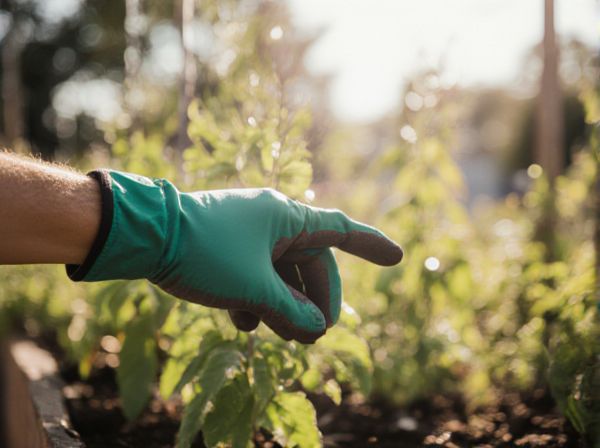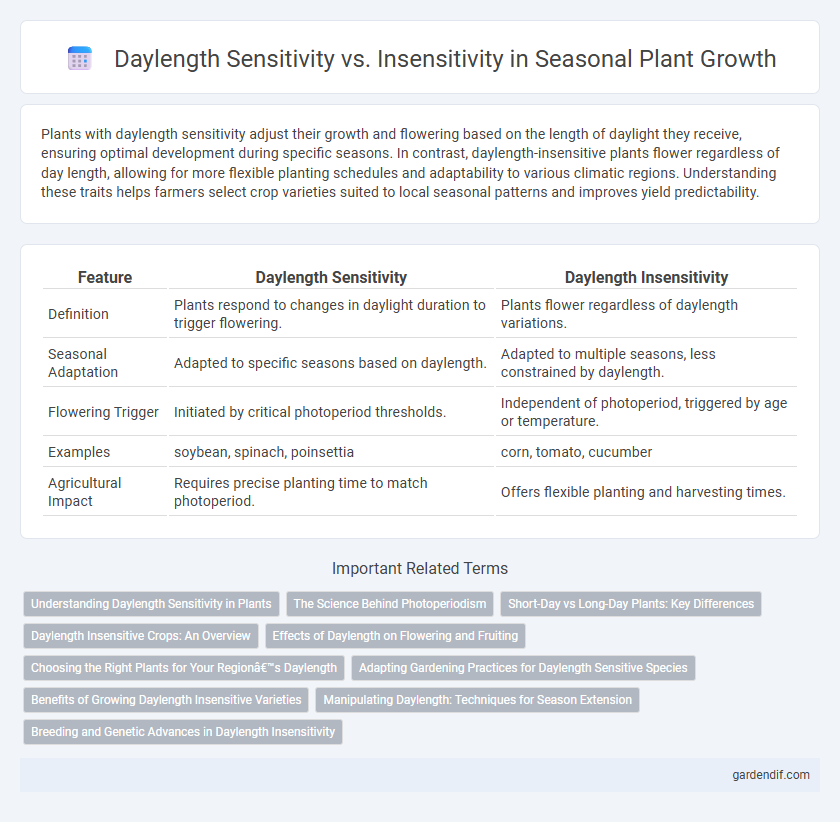
Daylength sensitivity vs Insensitivity Illustration
Plants with daylength sensitivity adjust their growth and flowering based on the length of daylight they receive, ensuring optimal development during specific seasons. In contrast, daylength-insensitive plants flower regardless of day length, allowing for more flexible planting schedules and adaptability to various climatic regions. Understanding these traits helps farmers select crop varieties suited to local seasonal patterns and improves yield predictability.
Table of Comparison
| Feature | Daylength Sensitivity | Daylength Insensitivity |
|---|---|---|
| Definition | Plants respond to changes in daylight duration to trigger flowering. | Plants flower regardless of daylength variations. |
| Seasonal Adaptation | Adapted to specific seasons based on daylength. | Adapted to multiple seasons, less constrained by daylength. |
| Flowering Trigger | Initiated by critical photoperiod thresholds. | Independent of photoperiod, triggered by age or temperature. |
| Examples | soybean, spinach, poinsettia | corn, tomato, cucumber |
| Agricultural Impact | Requires precise planting time to match photoperiod. | Offers flexible planting and harvesting times. |
Understanding Daylength Sensitivity in Plants
Daylength sensitivity in plants, also known as photoperiodism, determines the timing of flowering based on the length of daylight exposure. Short-day plants require longer nights to initiate flowering, while long-day plants flower when nights are shorter than a critical length, and day-neutral plants are unaffected by photoperiod changes. Understanding the molecular mechanisms of photoreceptors and circadian clocks helps optimize crop yield and adapt plant growth to seasonal changes.
The Science Behind Photoperiodism
Photoperiodism is the biological response of organisms to the length of day or night, primarily influencing flowering and breeding cycles in plants and animals. Daylength sensitivity in plants triggers physiological changes when critical periods of light or darkness are detected, mediated by phytochrome and cryptochrome photoreceptors. Insensitive species do not rely on photoperiod cues and often respond to other environmental factors, such as temperature or nutrient availability, enabling adaptation across diverse climates.
Short-Day vs Long-Day Plants: Key Differences
Short-day plants require a night length longer than a critical threshold to initiate flowering, making them sensitive to longer nights typically found in fall and winter seasons. Long-day plants, conversely, flower when nights are shorter than their critical length, usually during spring and summer, responding to extended daylight periods. This difference in photoperiodic response determines their geographical cultivation and seasonal growth cycles, optimizing flowering time for environmental conditions.
Daylength Insensitive Crops: An Overview
Daylength insensitive crops, such as rice, wheat, and maize, can flower and mature regardless of changes in photoperiod, allowing for flexible planting seasons and multiple harvests annually. These crops exhibit genetic adaptations that decouple flowering time from daylength, enhancing productivity in diverse agroclimatic zones and mitigating risks associated with erratic seasonal patterns. Their cultivation supports intensified cropping systems and contributes to food security by accommodating varying environmental conditions without compromising developmental stages.
Effects of Daylength on Flowering and Fruiting
Daylength sensitivity directly influences flowering and fruiting times by regulating photoperiodic responses; plants classified as short-day or long-day species flower only when daylength falls below or exceeds critical thresholds. Insensitive plants, or day-neutral species, maintain consistent flowering and fruiting patterns regardless of daylength variations, enhancing adaptability across different growing regions. Variations in daylength affect hormonal signals such as florigen, which triggers flowering, thereby impacting crop yield and reproductive success.
Choosing the Right Plants for Your Region’s Daylength
Selecting plants based on their daylength sensitivity ensures optimal growth and flowering aligned with your region's photoperiod. Long-day plants like spinach and lettuce thrive as days lengthen, while short-day plants such as chrysanthemums and soybeans flower when nights extend. Understanding your area's daylight patterns and matching plants accordingly maximizes yield and garden success.
Adapting Gardening Practices for Daylength Sensitive Species
Daylength sensitivity significantly influences the growth cycles of many plant species, making it crucial for gardeners to tailor practices according to photoperiodic responses. For daylength-sensitive plants like chrysanthemums and soybeans, adjusting planting schedules and using supplemental lighting or shading can effectively manage flowering and yield. Understanding species-specific photoperiod thresholds enhances crop adaptation, ensuring optimal development in varying seasonal daylengths.
Benefits of Growing Daylength Insensitive Varieties
Daylength insensitive varieties offer the benefit of flexible planting schedules, enabling cultivation across diverse geographic regions without being restricted by photoperiod requirements. These varieties often lead to more consistent yields since they can flower and mature regardless of daylength fluctuations, enhancing crop reliability. Their adaptability supports multiple cropping cycles per year, increasing overall farm productivity and resource efficiency.
Manipulating Daylength: Techniques for Season Extension
Manipulating daylength through techniques such as artificial lighting and blackout curtains effectively extends growing seasons by controlling photoperiod exposure in crops. These methods optimize developmental phases in photoperiod-sensitive plants, enhancing yield and quality beyond natural seasonal constraints. Advances in controlled environment agriculture leverage precise light duration adjustments to mitigate seasonality impacts on plant physiology.
Breeding and Genetic Advances in Daylength Insensitivity
Daylength insensitivity in crop breeding allows for the development of varieties that flower independently of photoperiod, enabling cultivation across diverse latitudes and extended growing seasons. Advances in genetic research have identified key genes, such as the CONSTANS and FLOWERING LOCUS T homologs, which regulate photoperiod response and facilitate the manipulation of flowering time. Modern biotechnological tools, including CRISPR-Cas9 gene editing, accelerate the creation of photoperiod-insensitive cultivars, enhancing yield stability and adaptability under variable environmental conditions.
Daylength sensitivity vs Insensitivity Infographic

 gardendif.com
gardendif.com